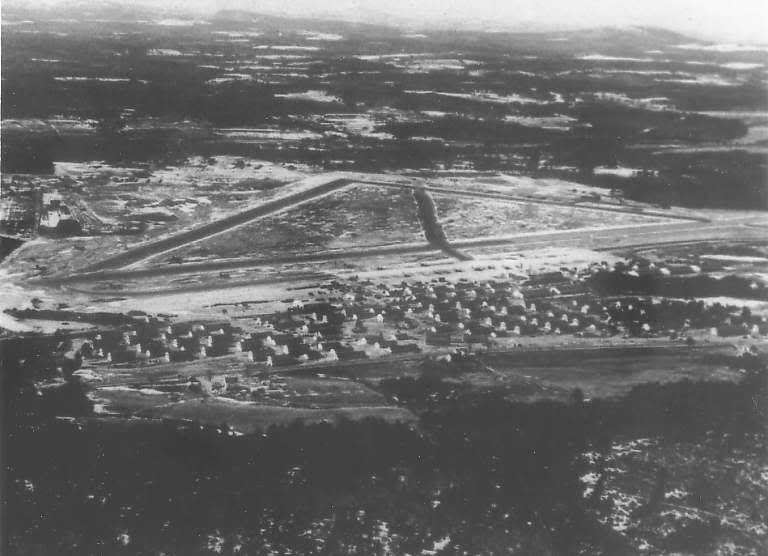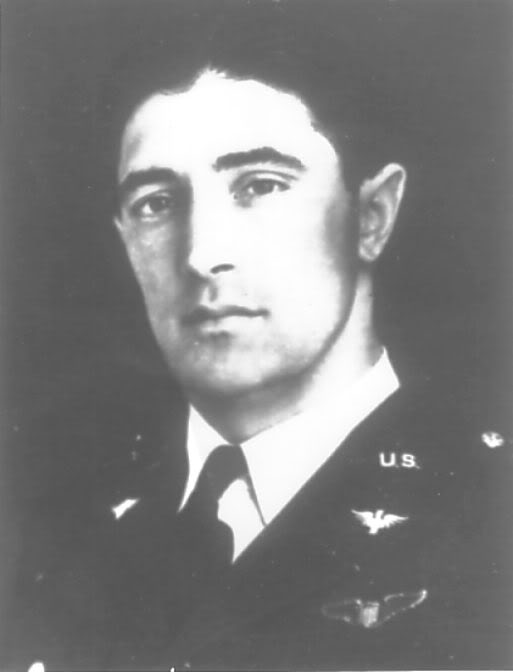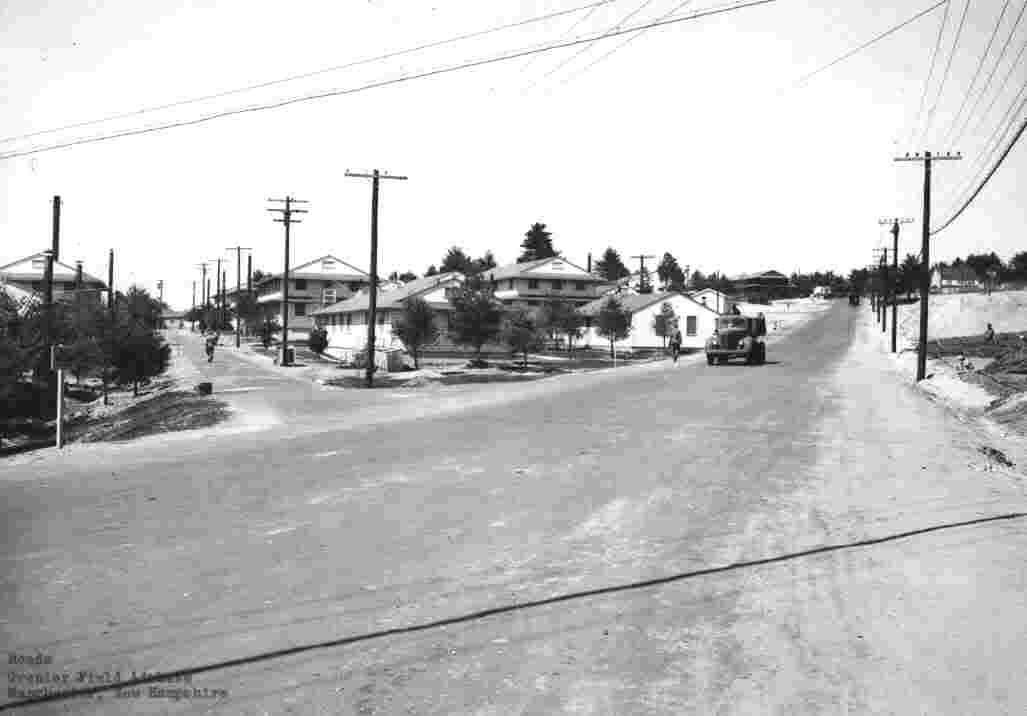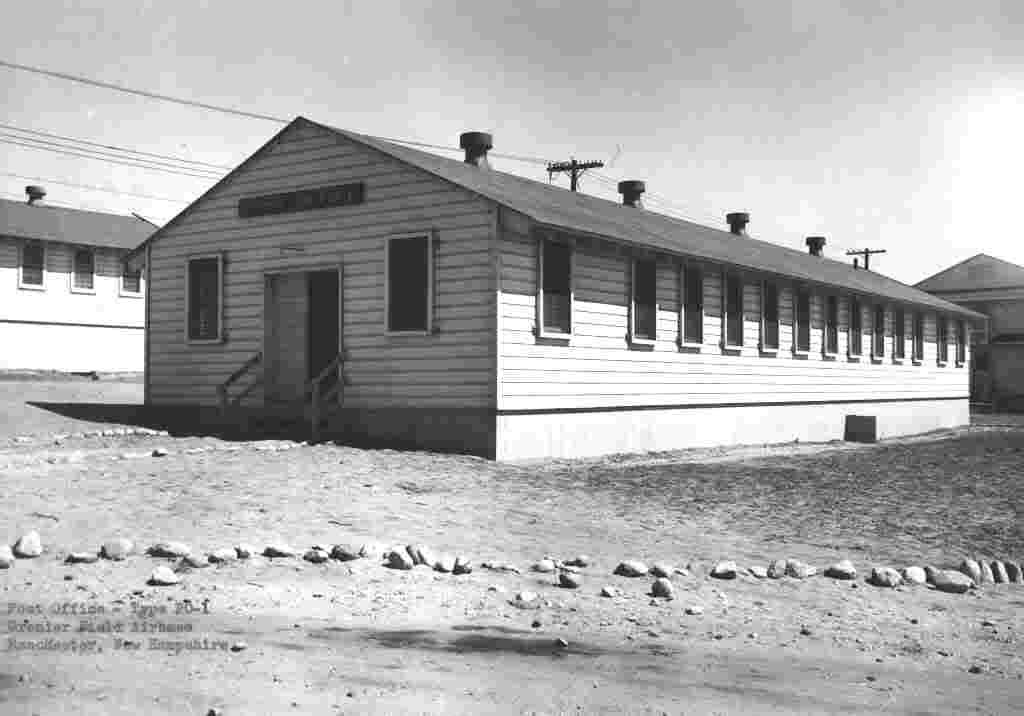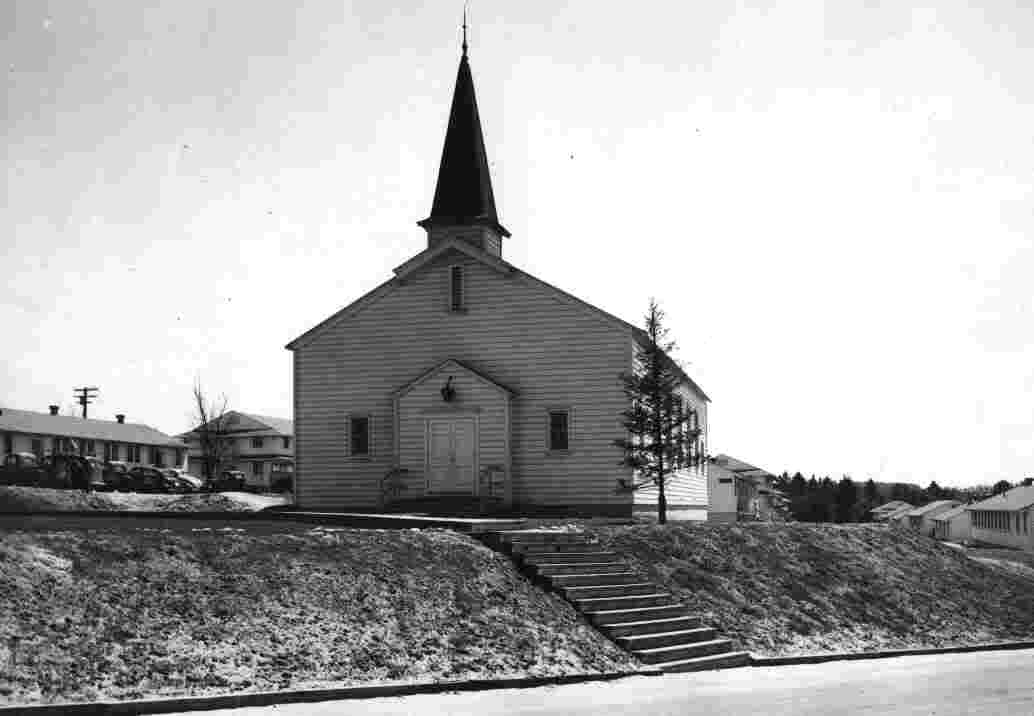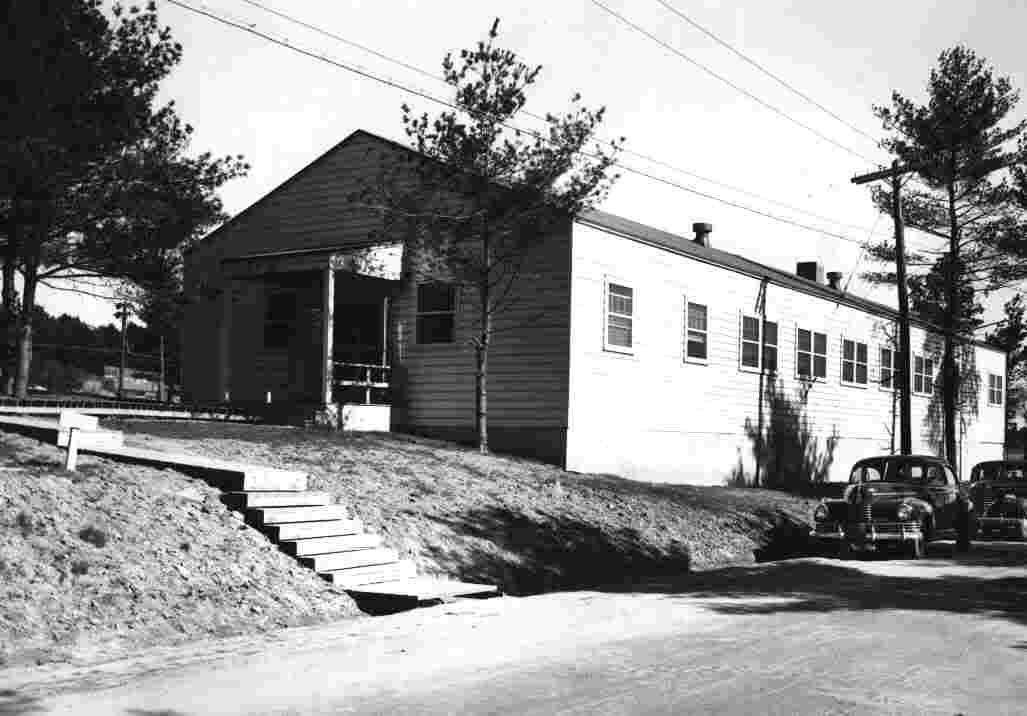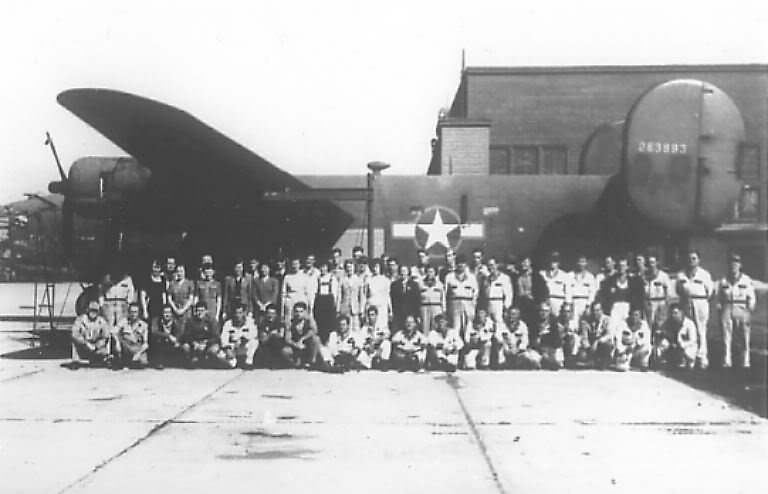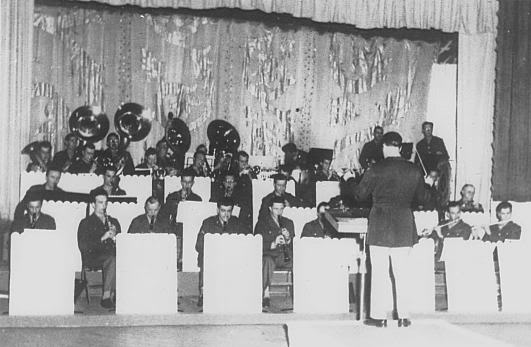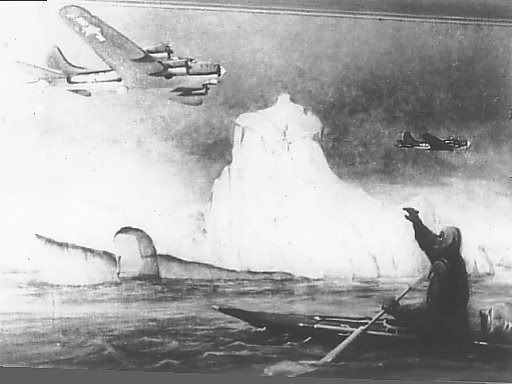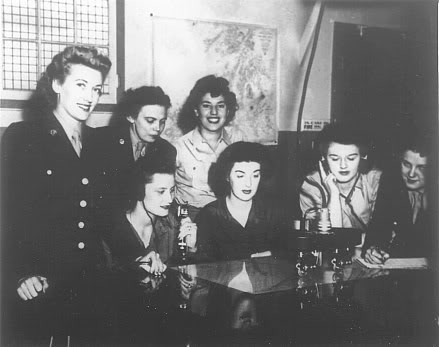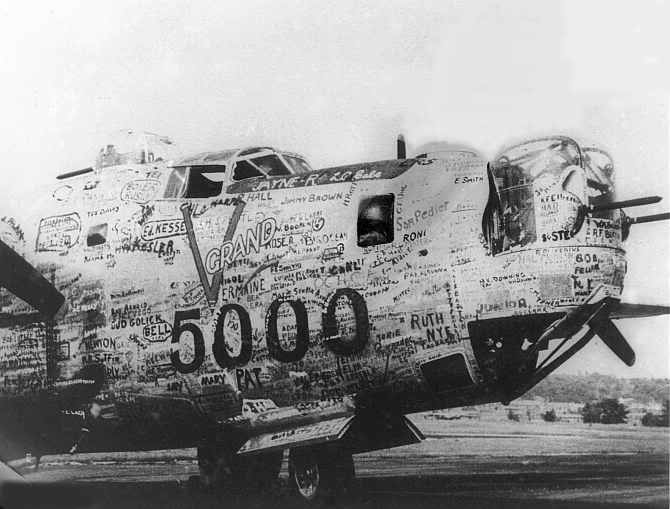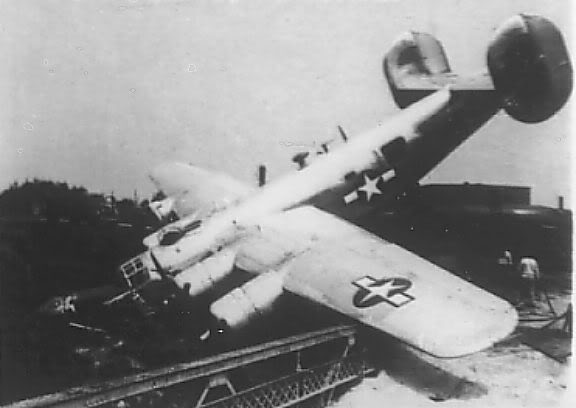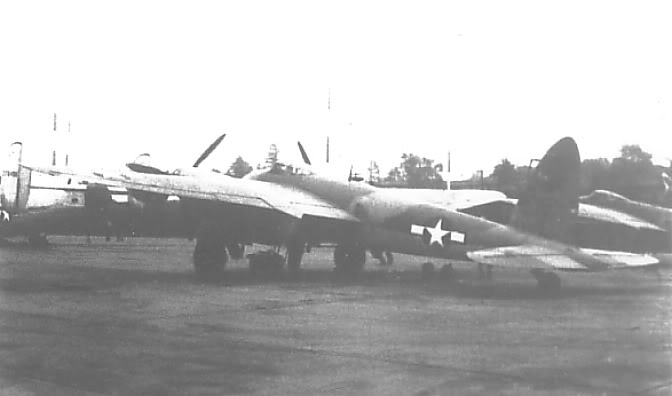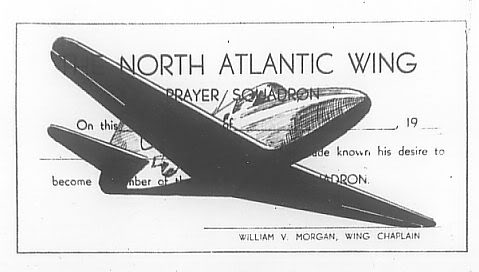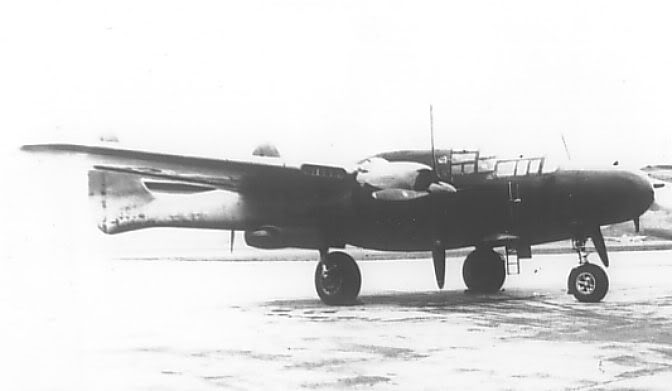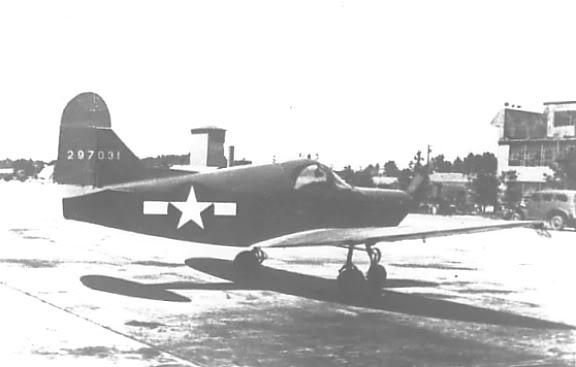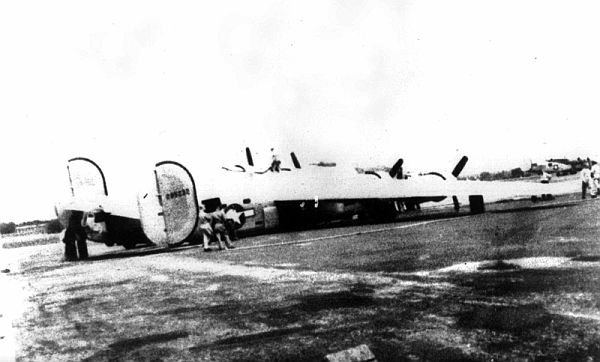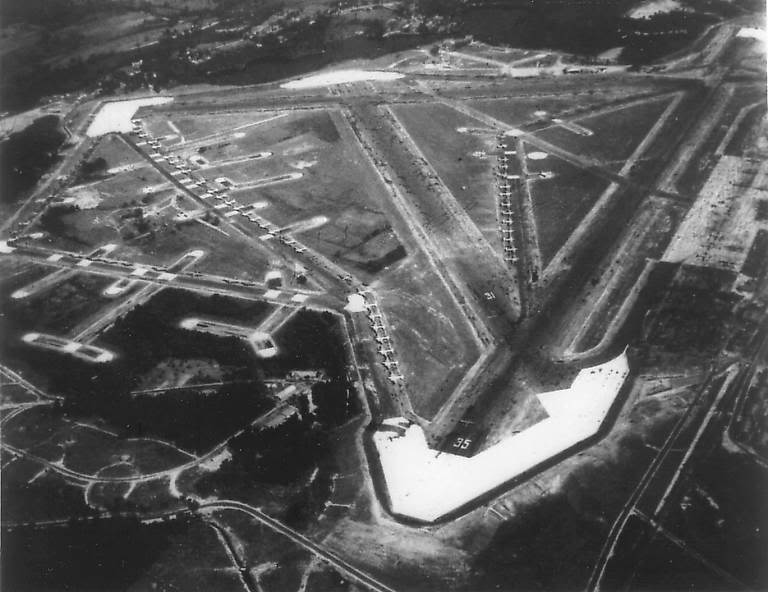|
MANCHESTER, NH AIRPORT
(MHT)
The World War Two Years
by
Tom
Hildreth
Manchester Airport in southern New Hampshire has grown to
become one of the leading regional airline facilities in the country. The
modern terminal and parking garage are both due to receive additional
expansion, and recently completed improvements to runway 6-24 will now
enable extensive work to continue on runway 17-35 which is the airport's
longest. In the year 2000, 3.5 million passengers were expected to use
this southern New Hampshire airport, which has successfully capitalized on
congestion and surface transport problem at Boston's Logan Airport in
Massachusetts. Recognizing the potential in this market, airlines serving
Manchester are providing larger, quieter and more modern equipment such as
the Boeing 757 and Airbus A320. Nearly 100 airline movements per day
support these burgeoning passenger operations, which now include flights
to Canada. Executive aviation has seen a boost in the form of the large
new facility operated by Wiggins, located on the east side of the long
runway opposite the new airline terminal.
During a crucial part of
World War II, this airport was for the primary staging base for heavy
bombers en route to the war in Germany. The North Atlantic Wing of the Air
Transport Command, which was headquartered not far away in Manchester, ran
this massive airlift operation. The sharp-eyed traveler today can still
catch a glimpse of the airport's wartime history. A group of wooden
two-story barracks still exists in the southwest corner of the property,
not far from the UPS and Fedex facilities. Located among the tall pines in
this area, these remnants of Grenier Army Air Field house a number of
small businesses.
The success of Charles A. Lindbergh in crossing
the Atlantic Ocean in his single-engine "Spirit of St. Louis" in 1927
sparked great interest in aviation worldwide. Manchester, like most
American cities, embraced the aviation phenomenon with enthusiasm. On
August 25 of that year a loan was approved for $15,000 to establish an
airport in the Queen City. Construction of two 1800-ft. runways began on
October 25, at what became known as Smith Field. The airport saw gradual
improvement during the 1930s, including the federally-funded construction
of a hangar and administration building for $500,000. During this time the
runways were paved with asphalt. A Civilian Pilot Training program was
begun in 1939 under the auspices of the Civil Aeronautics Administration.
This led to a tremendous increase in flying activity at Smith Field. This
program was run by Granite State Airways, and more than 100 pilots were
turned out during 1939 and 1940.
As the war in Europe approached,
neutral America belatedly recognized the threat posed by the axis powers.
American industrial output rose to meet Allied demands for war materials,
and American and military planners recognized the need to expand our
meager network of military airfields. As far back as 1935, the Wilcox Act
recommended construction of several very large new military airfields. One
of these was to be located in the Northeast.
Manchester Police
Chief James F. O'Neil had been a strong supporter of aviation in the area,
and was one of the driving forces behind establishment of an airport in
the city. When O'Neil learned that federal officials were looking for a
location for a military airbase in the Northeast, he persuaded the Army to
investigate the development of Manchester Airport into the huge airbase
that was envisioned. Though the Army selected Chicopee Falls,
Massachusetts to be the site of the proposed Northeast Airbase, they did
not loose interest in Manchester. Transatlantic air travel was on the
rise, and the fog problem at the Boston and New York airports enforced the
belief that Manchester's inland location would provide a suitable
alternate landing site.
On October 3, 1940, the War Department
announced that the Manchester Airport would be developed as Manchester
Army Air Base. Expansion efforts began immediately. The Works Project
Administration (WPA) broke ground on October 7 under a $1.5 million
allotment for base construction. During December, work began around the
clock on the strengthening and expansion of the airfield's runway and
tarmac areas. The D.A. Sullivan Company, of Northampton, Massachusetts, a
firm that still exists today, and the Caye Construction Company of
Brooklyn, New York, began construction of 118 air base buildings in late
January 1941. The contract specified completion of the work within 90
days. These companies, working with the WPA, the Manchester Water Works,
and the Army Corps of Engineers employed approximately a thousand men
during the height of the construction phase.
Beginning in the dead
of a New Hampshire winter, the rapid construction of the base was a
remarkable feat. Heavy snow blanketed the site when the project began in
late January 1941, but by June the empty field had been transformed into
an airbase capable of housing more than 2,000 people. When Lt. Col. John
I. Moore arrived on April 1 to take command of the new airbase,
construction activities were in full swing. Runway and tarmac expansion,
begun in the fall of 1940, had continued through the harsh winter. Within
a week of Moore's arrival, the Caye Company had completed all 94 buildings
in their contract, and on May 7, the D.A. Sullivan Company completed the
24 buildings for which they were responsible. Utility connections to the
base were also being completed, and the Manchester Water Works and the
Works Project Administration (WPA) finished water and sewer connections by
April 21. An advertisement by the Public Service Company of New Hampshire,
supplier of electricity to the base, showed a formation of trimotor
aircraft flying over a power line and proclaimed, "So proudly we hail
Manchester's new Army Air Base..."
Officers from the 33rd Air Base
Group at Mitchell Field, Long Island arrived at Manchester to inspect the
air base project on March 5, 1941. Lt. Col. John I. Moore arrived on April
1 to take command of the base. The first military aircraft stationed at
the base, a single engine Northrop A-17 monoplane, arrived on April 25.
The 242nd Quartermaster Company arrived on May 20, bringing the first
troops to be assigned to the New Hampshire airbase. The 717th and 449th
Ordnance Companies arrived by truck convoy from Langley Field, Virginia
less than a week later. Members of the 45th Bomb Group (Light) under the
command of Lt. Col. George A. McHenry began to arrive by troop train and
truck from Savannah, Georgia, on June 18, 1941. Official Air Force records
show that this group was comprised of the 78th, 79th, 80th and 433rd Bomb
squadrons. Initially these units operated obsolete Martin B-10 and Douglas
B-18 bombers as interim training aircraft, until the arrival of the
Douglas A-20 Havoc later in the year.
By early July, the 125-bed
base hospital had opened its doors under the command of Capt. William D.
Willis, Base Surgeon. This facility was to be manned by a medical
detachment of 125 people with 1Lt. Bertha Elsner acting as Chief Nurse.
This hospital occupied fifteen different buildings, and would later be
designated as an Air Evacuation Center for war casualties returning from
combat in Europe.
Training of combat aircrew stationed at
Manchester required access to a practice bomb range, and in 1941 the
government acquired a plot of land near Joe English Mountain in New
Boston, New Hampshire. By the end of the year work had begun to establish
a bomb range in this hilly area 16 miles west of Manchester. Today, the
Air Force's New Boston Satellite Tracking Station stands on a portion of
the government property at this site, while the remainder of the range has
been converted to recreational use.
Capt. Frederick C. Bothwell, a
West Point graduate, commanded the 717th Ordnance Company (Aviation) Air
Base, and was assigned as Base Ordnance Officer. His assistant was Lt.
William J. Priest, who commanded the 449th Ordnance Company (Aviation)
Bombardment. Lt. Priest led all Ordnance personnel on a three-day exercise
to Bradley Field, Connecticut beginning on the 28th of August. The purpose
of the trip was to familiarize the men with truck convoy movement and to
study Ordnance functions involved in the supply and issue of material to
pursuit squadrons. At that time the 57th Fighter Group at Bradley was
operating Curtiss P-40 Warhawks.
Tactical and training activities
at Manchester were controlled by the 33rd Air Base Group and its component
34th and 35th Air Base Squadrons. Other units assigned to the base at that
time included the 1st Chemical Company, 17th Reconnaissance Squadron, 30th
Signal Platoon, and the medical detachment. By October the arrival of
small arms and automotive repair trucks allowed the Ordnance troops to
begin training in earnest. They had also completed construction of a skeet
range on base. An ample supply of practice bombs had arrived, which
allowed munitions personnel to learn their serious trade. On October 9 the
578th Army Air Forces Band was activated on the base. The original cadre
of four enlisted men, led by SSgt. Nathan Rosenstein, came from the 1st
Infantry Division at Ft. Devens, Massachusetts.
The events at Pearl
Harbor on Sunday, December 7, 1941, had an immediate impact on base
activities. In a remembrance of Pearl Harbor day published in the
Manchester Union Leader in December 1993, retired Col. William A. Whelton
wrote of the unprepared posture of the base that fateful Sunday. All of
the bombs present were small practice weapons incapable of being used
effectively against an enemy, and there was no ammunition for the few
machine guns that were on base. In desperation, Whelton flew to Westover
Field where he hoped to find some ammunition. This lamentable situation
changed almost immediately when the first squadron of A-20 Havoc light
bombers arrived to equip the 45th Bomb Group following a 47-minute flight
from Mitchel Field, New York.
By December 15 large quantities of
live bombs were stored in the open at Manchester. The igloos for these
weapons were not scheduled for completion until the end of January 1942.
Ordnance personnel hastened to set up temporary bomb targets and a machine
gun range in New Boston. By February, construction of a permanent bomb
range was underway, with two of the three observation towers for range
control about to be erected. . In certain respects the Havoc aircraft were
unusual, as they were actually DB-7 export versions, originally intended
for France. This temporarily created a problem for base munitions
personnel, as the bomb suspension system had to be modified to make it
compatible with American bombs.
German submarines had begun to take
their toll of Allied shipping, and Manchester-based aircraft armed with
USN 325-lb. depth bombs participated in the search for the U-boats. The
stocks of bombs and ammunition on the base were growing rapidly. In fact,
the quantities of large demolition bombs exceeded the capacity of the
newly completed indoor storage and were placed in outdoor revetments. The
13th Anti-Submarine Squadron began operating from Grenier during the
summer of 1942 with B-25B & C Mitchel bombers and a number of Lockheed
B-34 Ventura aircraft. Typical patrol missions were 4-6 hours duration and
usually involved convoy escort off the New England coast. The aircraft
were normally armed with #325 depth charges. The 13th remained at Grenier
until September 1943, by which time the unit was also operating B-24D
Liberator bombers.
On February 22, Manchester Air Base was renamed
Grenier Field after Manchester resident 2Lt. Jean D. Grenier. A popular
athlete and graduate of the University of New Hampshire, Grenier had died
in the crash of an Army A-12 aircraft in Utah while flying a mail route on
February 16, 1934.The residents of the Manchester area had quickly become
familiar to the drone of the bombers operating out of Grenier Field, but
changes were soon to come. On May 16 1942, the 45th Bomb Group transferred
to Dover, Delaware, a move that came on the heels of the 717th Ordnance
Company's departure for Fort Dix, New Jersey. The airbase was still
growing in size and capability at this time. A new ordnance area had just
opened on the south side of the airfield, and armament personnel finally
had a suitable shop for handling guns and ammunition. New munitions igloos
allowed proper indoor storage of bombs for the first time, just as
ordnance personnel began to ship some of the base's stockpile of these
weapons to other airfields.
Grenier Field became involved in a
bold Army Air Force plan known as Bolero in June, 1942. Bolero was a code
name for the rapid buildup of American combat forces in England. Wartime
transatlantic crossings by multi-engine aircraft had become routine, but
the supply of fighter aircraft to England was a different matter. The most
common method of crossing had been as deck cargo aboard surface vessels.
Aside from being prohibitively slow and risky, this method exposed the
relatively delicate airframes to manhandling and the corrosive effects of
saltwater. An innovative plan was developed whereby the fighters would be
ferried across the ocean in a series of short hops with navigational
assistance provided by bombers. Most Bolero fighters departed from Presque
Isle AAF, Maine, but during June 1942, the 52nd Fighter Group began to
work up with Bell P-39 Airacobras at Manchester. Army Air Force leaders
soon decided the P-39 was not an ideal fighter for the European theater,
and the personnel of the 52nd went to England by ship. It wasn't until
late in the year, after being reequipped with the legendary Spitfire
fighter, that the 52nd began to operate from England as a combat fighter
group.
The 578th Army Air Forces Band proved to be very popular
throughout the greater Manchester area. Comprised of a full orchestra and
a swing dance band the military musicians highlighted many Army Air Force
recruiting drives in New Hampshire. Their itinerary included stops in the
New Hampshire capitol city of Concord, a North Country appearance in the
paper mill town of Berlin, and Bay State concerts in Boston and Ft.
Devens. Washington sent out requests for recordings from the band, and the
Grenier Field March, written by Assistant Conductor and clarinetist SSgt.
John Pastor was submitted. No evaluation of the music was ever returned by
headquarters, but this didn't faze the irrepressible musicians.
On
September 25, 1942, the Manchester Union-Leader, in cooperation with local
radio station WFEA, arranged for an overseas short wave broadcast of the
Grenier Field Band as part of the "For the Boys" concert series. In
October the band played at the 315th Fighter Squadron dance at the IOOF
hall in Manchester. (The 315th was equipped with Curtiss P-40s and trained
at Grenier for several months before departure to El Kabrit, Egypt as part
of the 324th Fighter Group). Other talent was in town as well. Dorothy
Lamour, a popular performer at the time who frequently accompanied Bob
Hope made a flight line stage appearance at Grenier.
The month of
July 1942 brought the inactivation of the 449th Ordnance Company, one of
the first Army Air Force units to arrive at Manchester. Many members had
already transferred out, leaving one officer and fifteen enlisted men who
were incorporated into the 34th Base HQ and Air Base Squadron. At this
time ordnance personnel assumed all motor vehicle maintenance
responsibility, which was previously handled by the Base Quartermaster.
The mettle of the ordnance personnel that remained was tested the
following month when they were required to support the bombing and
gunnery-training missions of a Heavy Bomb Group.
The recruiting
drives brought results, and large numbers of inductees arrived in
Manchester for basic training. Assigned to casual detachments, these
recruits were quickly introduced to Army Air Force life. Large numbers of
New England area women also arrived to be initiated into the Women's Army
Corps. The groups of trainees varied greatly in size, some casual units
were comprised of one or two hundred members, while others would exceed a
thousand. When the training was completed, these units would be assigned a
shipment number and depart the base in secrecy, usually headed for the
port of Boston on a troop train. The Boston and Maine rail line that
serviced the airbase maintained a busy timetable that offered sixteen
round trips per day. Some incoming personnel shipments had been trained
elsewhere, and while they often looked well-prepared on paper, officers at
Grenier quickly learned clothing and equipment deficiencies were
commonplace. Inspections were frequent, and in order to rectify the
equipment problems quickly, it was necessary for airbase personnel to
maintain a close relationship with the Boston Quartermaster, the source of
replacement goods.
Grenier AAF remained under the control of the
First Air Force at Mitchell Field, New York from mid-1942 to mid-1943. A
significant portion of the personnel and aircraft assigned to the Eighth
Air Force in England had passed through Grenier. The New Hampshire airbase
was making a huge contribution to the war effort, which in turn helped
open up the European Air Offensive on July 4, 1942. By the fall of that
year antisubmarine patrols off the New England coast had led to a marked
decrease in U-boat activity. By August 1943, the Navy had assumed
responsibility for most of the antisubmarine missions previously flown by
the Army Air Force. This resulted in a decline in flight operations at
Grenier, and shifted the base's mission to the training of recruits.
Air Transport Command (ATC) personnel visited Grenier on December
4, 1943, and recommended the North Atlantic Wing (NAW) relocate there from
Presque Isle AAF, Maine. The New Hampshire site offered several major
advantages over the previous location. There were three 150 foot-wide
paved runways at Grenier that ranged in length from 5500 feet to 7000
feet. The annual snowfall was considerably less than the Maine location,
and close proximity to the coast made it a convenient alternate landing
site for aircraft inbound from Europe. Manchester was not without
shortcomings. Only one of the six hangars at Grenier could properly
accommodate heavy bombers. No suitable building on base existed to house
the Wing headquarters section, so the Reconstruction Finance Corporation
offered the Hoyt Building at 497 Silver Street for this purpose. Known
today as the Silver Towers, this historical edifice still stands in
Manchester at that address.
Under the command of Colonel (later
Brigadier General) Lawrence G. Fritz, NAW operations began at Grenier
Field on January 1, 1944. Fritz had flown the North Atlantic route many
times as vice president in charge of operations at TWA, and was an
excellent choice for this position. Colonel John I. Moore, the original
base commander at Manchester, had been in Washington on detached duty
since August 1943. In Moore's absence, Colonel Roscoe C. Wriston took
command of the airbase, and eventually passed these responsibilities to
Colonel Marlowe M. Merrick. Grenier Field's main mission at this time was
to equip and process transient heavy bombers and aircrew for overseas
duty. Base personnel quickly aligned all of their efforts to support this
critical role. Manchester soon became an Aerial Port Of Embarkation
(APOE), and the first group of B-17s passed through the base on January
18. By the end of 1944, the North Atlantic Wing would supervise the
shipment of nearly 9000 tactical aircraft to Europe and Africa from bases
in the northeastern United States. A total of 170 B-17s arrived in
Manchester in February, by which time extreme cold along the Northern
Route had become a hazard. At Goose Bay, Labrador, fliers suffered
frostbite as they serviced their aircraft. The majority of these young
combat crewmen had recently trained at southern U.S. bases, and it became
the responsibility of instructors at Grenier to quickly educate them on
the hazards of winter flying.
Mishaps affected a small percentage
of the aircraft that passed through Manchester. Some of these episodes
were humorous, while others were tragic. One B-17 pilot gave the bail out
order over Portland, Maine because of problems with the aircraft's
autopilot. Upon further diagnosis of the problem, the officer rescinded
the order, but the tail gunner had already hit the silk. After he landed
unhurt in the town of Northrup, Maine, the gunner returned to Grenier to
rejoin his crew for a less eventful departure. Disaster struck on April
24, when a B-24 took off from Manchester and crashed into Washtub Hill in
Epsom, New Hampshire, with the loss of all ten aboard. The New Hampshire
countryside would be the scene of other terrible crashes as hundreds of
the bombers droned overhead in the coming months. Transient combat
aircraft virtually poured into Manchester in June 1944. The monthly total
was 572 tactical aircraft arrivals, with a one-day high of 107. Of the 270
B-17s that arrived, the majority came from Kearny, Nebraska, while most of
the 189 B-24s came from Hamilton AAF, California, and Mitchel AAF, New
York. These bombers consumed 789,042 gal. of 100/130 octane aviation fuel.
Aircraft maintenance activities in support of these planes accounted for
22,800 man-hours. Grenier workers began to process U.S. Navy PBY
Catalinas, B-24s, and PB4Y Privateers for overseas duty, and this pushed
the July statistics far beyond those of June.
The Priorities and
Traffic Office (P&T) acquired the use of the Northeast Airlines
terminal on the north side of the airfield to expedite aerial movement of
priority cargo and passengers. Two C-46 flights were routed through
Manchester for this function. One flight ran from Newark, New Jersey to
Presque Isle AAF, Maine, and the other from Boston, Massachusetts to the
northern Maine base. The approach of a hurricane in September led to the
evacuation of many Grenier-based planes to Montreal. The only damage on
base occurred when a storage structure was toppled. During the storm, a
Navy F6F Hellcat fighter made an emergency landing in Rockingham, New
Hampshire. The aircraft was undamaged and the base recovery team simply
folded its wings and towed it to Grenier via highway. The Station Hospital
was very active from August to October 1944. Airbase medical staff gave
physicals to 16,128 transient airmen, and performed 84 emergency
surgeries. The station hospital assumed additional responsibilities when
Grenier became an Air Evacuee Center for wounded personnel enroute to
stateside hospitals from the European theater. The number of transient
bombers began to decline after September 1944. Base production shops
turned their attention to installation of bomb bay fuel tanks and weather
observation equipment in the B-17s and B-25s used by the 1st Weather
Reconnaissance Squadron. This unit was attached to the 8th Weather Region,
headquartered at Grenier.
As the winter of 1944-1945 approached,
cold weather again became a threat to flight crew safety on the Northern
Route. Frostbite among aircrew became such a serious problem at Goose Bay
that the Labrador airfield was temporarily closed. The cold weather also
began to plague the aircraft, especially the B-24 Liberator. Held at
Grenier due to cold weather landing gear malfunctions, shipments of these
bombers were soon redirected to southern routes. The winter of 1944-45
brought record-breaking snowfall to Grenier Army Air Field in Manchester,
New Hampshire. The season total was 73.4 inches, according to records kept
by the 8th Weather Region at the airbase. This was the most in a single
season since the airbase had opened, and according to local sources, the
most the Granite State had seen in many years. Snowplow crews worked hard
to keep the runways open to air traffic. In spite of these efforts, many
weather-related mishaps took place. On January 5,1945, a B-17 hit a
snowbank and lost its tail wheel during an attempted landing. As a
precaution, the crew jettisoned the bomber's ball turret into Lake
Messabesic while setting up for another approach. The pilot landed the
Flying Fortress without further problems. In a different incident, a B-24
pilot claimed his aircraft received damage due to an obstruction on the
runway. An investigation revealed a slightly different story. The
Liberator pilot had made a landing approach into the glare of the low
winter sun, and had put the big bomber down on the frozen ground between
the runway lights and adjacent snowbank! A blizzard arrived on February 7,
which added to the accumulated snow depths. The 135th Army Airways
Communications Service (AACS) detachment had worked to install a new
navigational and approach aids at the base radio range in South
Londonderry. They were unable to reach areas of the site due to snowdrifts
that exceeded a depth of 10 feet. The airbase sent down a bulldozer and a
"Snogo" rotary plow to open up the access road to the radio
shack.
The processing of tactical aircraft at Grenier Field had
peaked during the summer of 1944, but there was still a substantial flow
of bombers enroute to the European and Mediterranean theaters. Unusual
aircraft occasionally showed up, as on February 23, when General
Eisenhower's personal YC-108 transport arrived. This VIP aircraft,
modified B-17F 42-6036, departed for Stephenville, Newfoundland the
following day. The newest in transport aircraft arrived two days later
when a Lockheed C-69 Constellation flew in from Washington National
Airport. The sleek aircraft was given a close look by members of the North
Atlantic Division (previously North Atlantic Wing), who were treated to an
impressive aerial demonstration by the large aircraft in the
afternoon.
By the end of March, 5,447 heavy bombers had passed
through Manchester since the beginning of NAW operations 15 months
earlier. Processing the 51,000 crewmen aboard these aircraft was a huge
task. Many of the crewmen were given physical exams by base medical
personnel. The staff at Grenier briefed the fliers on a wide range of
operational subjects such as cruise control, ditching at sea, navigation
techniques and radio procedures. Electrically-heated flight suits and box
lunches were issued to all. The aircraft needed preparation also. Engine
maintenance accounted for many thousands of man-hours. Flight controls had
to be rigged and hydraulic leaks repaired while machine gun ammunition and
other combat gear was taken aboard. For many of the aircraft the list of
maintenance discrepancies was long.
March 10, 1945 marked the
arrival of 37 aerial evacuees, the first since October of the previous
year. Grenier medical staff provided care for the casualties, and placed
them aboard C-47 transports for airlift to hospitals throughout the
country. Though officially downgraded to dispensary status, the airbase
hospital would process many of these cases in the coming months.
Although the airbase staff did their best to be hospitable to
those who passed through, the experience of the transient crews was no
picnic. The men were restricted to the base and not allowed to use the
telephone. Most of them passed their spare time by writing letters or
shopping at the Post Exchange. A few signed out athletic equipment and
engaged in sports activities. Virtually all of the men quickly realized
that the airbase had a sizable population of WACs. There were several
well-attended dances at the club every week.
On April 7 Manchester
received a message that alerted base personnel of significant change in
the near future. All B-17s and B-24s not equipped with radar were to
return to their point of origin. Bombers with radar were to proceed east
with flight crew only, while bombardiers and gunners were to debark at
Grenier. By the end of April, a subsequent directive grounded all
eastbound tactical movements. On April 26, in compliance with the earlier
directive, a group of bombers departed on a reverse course, back to bases
in the Western United States.
An OTU (Operational Training Unit)
for C-54 crewmen was activated at Grenier on May 7. Five Skymaster
transports were assigned to the school. The OTU enjoyed a very brief
existence. August 13 was the date of the final class. In that short time
span 53 first pilots, 50 co-pilots, 29 navigators and 67 aerial engineers
learned the trade of transport crewmen in New Hampshire skies. The latter
group included 9 members of the Royal Air Force.
A manning problem
developed at Air Transport Command (ATC) headquarters in the spring of
1945. Many troops of the command had served overseas for long periods and
were due for rotation to stateside airfields. At Grenier, the majority of
troops had not performed overseas duty. There were 1,402 men and women in
uniform at Manchester at the end of April. Two weeks later, NAD ordered a
rotation plan into effect that sent 500 Grenier troops to overseas
assignments, and another 500 to duty elsewhere in the Continental United
States. This resulted in skill shortages and personnel imbalances at the
airbase. A rumor declaring that Grenier Field was on the verge of
inactivation quickly surfaced. A political controversy broke out between
Maine and New Hampshire as each state fought to make its respective
wartime airfields into permanent peacetime installations.
The
personnel problems at Grenier struck the base just as the Army Air Force
announced it would fly 4,000 aircraft back to the United States as part of
the White Project plan. Manchester was tasked with operational control of
nearly all these westbound flights, many hundreds of which touched down at
Grenier.
During July, airbase leaders made plans to launch Green
Hornet Airlines. This C-54 operation was to follow a
Grenier-Azores-Stephenville-Grenier route. The idea had a short lifespan
however, and the flights operated for just 12 days in early August. Later
that month, ATC permanently dispatched the C-54s to the west coast to make
them available for use in the Pacific.
The level of activity at
Manchester declined steadily. On August 13, headquarters eliminated the
long-standing C-46 flights from Boston and Newark. Another decision led to
the inactivation of the C-54 OTU on the same unlucky date. Operation of a
small fleet of C-47 transports to the other NAD airbases became the
primary mission at Manchester. The workweek of civilian employees was
reduced from 48 to 40 hours in September, and the possibility of a layoff
loomed ahead. Many of the newly-assigned military people needed housing
for their families, but in the tight local housing market it was a
difficult task. As this situation worsened, the incoming troops were told
not to bring their families to Manchester.
An uncertain future lay
ahead for many of the nation's wartime airfields, including Grenier.
Beginning as early as 1943, military leaders had discussed the need for
the formation of National Guard and Reserve flying units following the
termination of hostilities. Manchester eventually became home to units of
the Air National Guard and Air Force Reserve. Grenier would host many
summer encampments for these reserve units. Even as these peacetime plans
for Grenier were being made, the emergence of the USSR as a nuclear power
affected the airfield's immediate future. The United States Air Force,
which had just been granted status of a separate branch of the armed
forces, was tasked with the need for tremendous expansion to meet the
perceived Communist threat. Grenier Air Force Base became host to the
first of New England's many Strategic Air Command units. These
developments and the use of the Manchester Airport in the postwar era will
be covered in a future article.
THE END
More Grenier Field
Articles and photos
|
